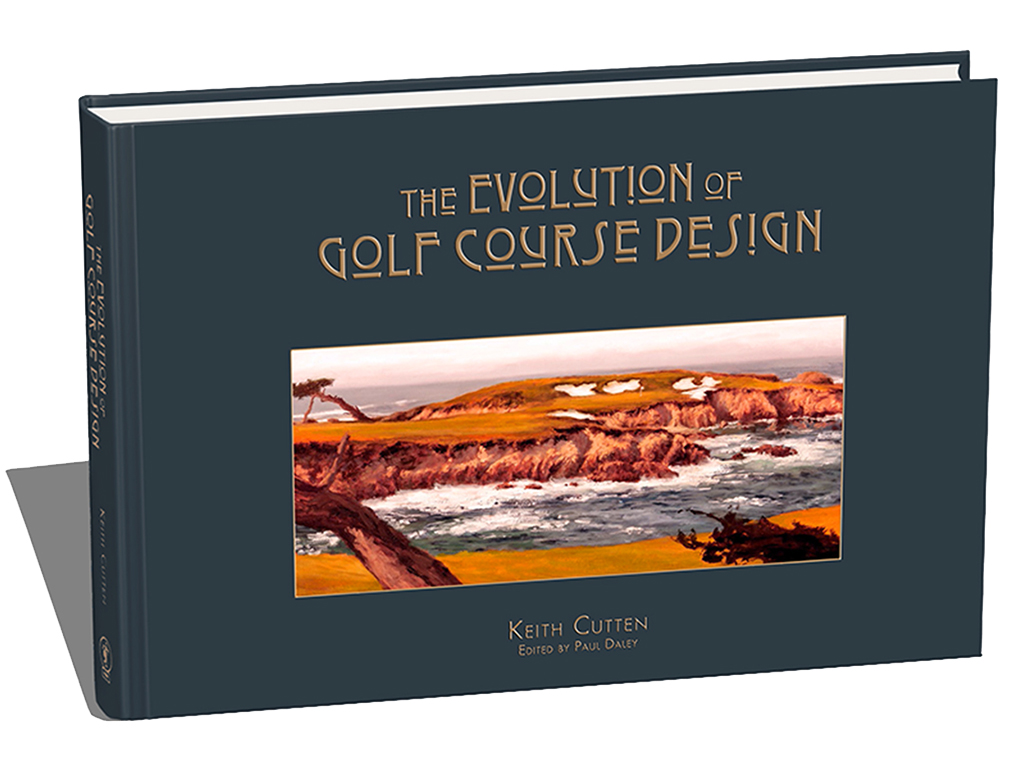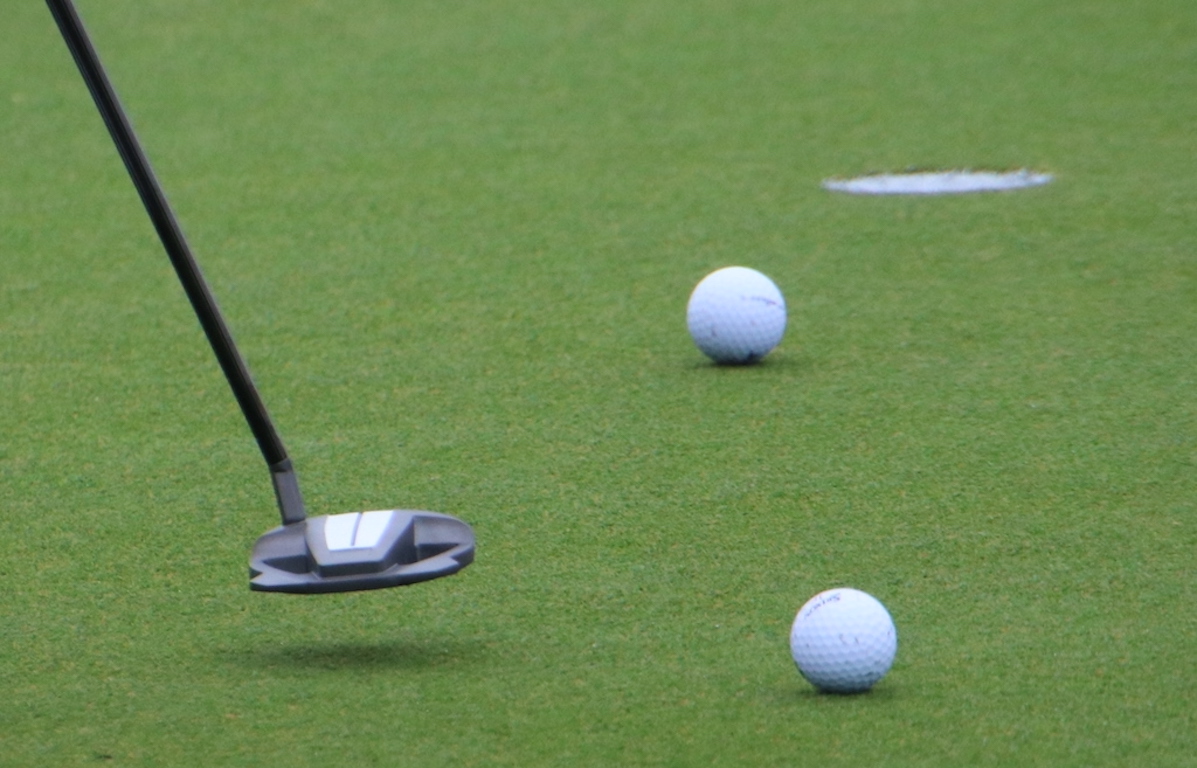News
An interview with Keith Cutten, author of “The Evolution of Golf Course Design”

This interview is with Keith Cutten, author of “The Evolution of Golf Course Design,” which is a new book he is releasing to the public. This is an unbelievably well-researched and all-encompassing look at golf course architecture, how it has changed throughout history, and all of the variables in play that have shaped it over the course of time.
Let’s start with the easy stuff. What’s your personal background? How did you get into all of this?
Well, my passion for golf architecture started back in high school. I took a drafting and design curriculum all through high school, which was hugely beneficial. I was getting into golf around 15-16 years old and I lost my grandfather, who was the primary golf influence in my life. When he died, he left me his golf clubs, and I missed him so much I just dove completely head first into golf.
When I finished high school, I sat down with my dad to try to hash out a game plan to get into the golf industry. My dad was an environmental scientist for 40 years with the Ministry of Environment in Ontario, so he helped me a great deal in understanding the policy system here in Canada. I started by getting my bachelor’s degree from the University of Waterloo in Planning and Environmental Design. In my last coop term, I went for broke and I reached out to Rod Whitman in Canada, who invited me to do a 5-month coop with him during the construction of Sagebrush Golf & Sporting Club in British Columbia. The pay was paltry and I ran a shovel and a rake for most of the summer, but I fell in love with it instantly.
I later went back for my master’s in Landscape Architecture at the University of Guelph, which I finished in 2016. The culmination of that was my thesis, which has now become this book. Nowadays, I have my own company, Cutten Golf, Inc., which allows me to partner with people like Rod and Dave Axland, who has been Coore and Crenshaw’s chief project manager for 30 years. I couldn’t have walked into a better situation as a young, aspiring architect. To have the opportunity to work with these guys is incredible.
Having had the opportunity to peek at an advanced copy, I can say the book is completely fascinating. Talk a little bit about what compelled you to devote so much of yourself to this pursuit in the first place.
I’m the type of person that needs to answer my own questions to be satisfied. I’m not comfortable with just accepting things as fact without knowing the story behind them. I was sitting in one of my first master’s classes, which was basically a history of the landscape architecture profession. I’m learning how everything is influenced by society and wars and economy and I thought, “This has to be true for golf, but no one’s ever talked about it.”
At the time, I was also batting around ideas for my thesis. I was thinking a lot about the renovations that had recently been done to Pinehurst No. 2 and I was particularly curious about how Donald Ross’s original design was so much more environmentally sound than what it had been allowed to become over the course of time.
One of the key quotes that I got from Bill [Coore] about that project was that they were not trying to be “environmental crusaders” so much as they were just trying to put the course back to the way Donald Ross had originally intended it. So the question I kept asking in my head was, “How did this happen?” I sort of went on a fact finding mission to uncover how golf course architecture changed and it kept snowballing. I just kept following leads in different directions that began to connect all the dots for me. I went a little deeper down the rabbit hole every day, and ended up with a 600+ page thesis to turn in.
Just to paint a quick picture for the readers as to what’s going on in the book, there’s two main sections to it. The first section is going through history decade by decade starting with the early origins of golf, then 1830s, 1840s, and so on. I don’t want you to give too much of your book away, but give people a taste for what’s going on there.
Essentially, there’s a lot of short little blurbs about historical context that I try to quickly tie into golf. I suppose you’d have to start with the Victorian era, which was the first attempt at going away from the “links” style of architecture. When people from urban areas (say London) found golf and wanted to play it, they wanted to create their own courses so they wouldn’t have to travel over to St Andrews. So, the professional golfers of the time built what they could. The only people that were doing construction of the landscape at that time were the crews that were building state homes for the ultra-wealthy in the Victorian style. So they wound up with golf courses that were built much the same way with features that were geometric and square. They looked nothing like the links courses of Scotland.
After that, there was then a shift into what’s called the Arts and Crafts movement that takes you into the 1910’s. WWI had a huge impact at that time. Britain was basically devastated after WWI, so a lot of architects fled to the US, the land of opportunity, which led to what we now call the Golden Age of golf course architecture.
Shortly after that period, you have the Great Depression and WWII, where all of this knowledge that had been built really just comes to a halt. After going through the Great Depression and WWII, society really didn’t want to think about the past. There was no fondness for what had been done, so modernism became the way of life for basically everyone at that point, including golf course architecture.
Most of the big name architects (Ross, Mackenzie, etc) started their careers back in England before WWI, so when you get to WWII, those guys are all either dead or retired. It was a perfect storm which basically took golf in a completely different direction.
The second part of the book is profiles on golf course architects, authors, and visionaries. So you go from Old Tom Morris to Geoff Shackelford and everywhere in between. Given how much time you’ve invested in this, I’m curious to know who you would put on the Mount Rushmore of architects and why?
I’m going to flavor this with my own personal bias, but for me number one has to be Harry Colt. He’s so brushed over in North America it’s crazy. He pioneered what golf course architecture is, which is combining strategy and naturalness. Colt’s influence can be seen in work of Dr. Alister MacKenzie (Australia and America), Hugh Alison (Japan), Stanley Thompson (Canada) and Donald Ross (America). His influence just can’t be overstated in my opinion.
Stanley Thompson would have to be my next choice. Especially since I’m Canadian. His projects have defined great golf here, and his influence on me was immense.
Third would be Bill Coore. Without Sand Hills, I don’t think we are where we are today when it comes to golf course architecture. I don’t think anyone is reading my book and I doubt I’m even writing if it wasn’t for Bill. I think he’s the Alister Mackenzie of our time.
Last would be Rod Whitman. He just doesn’t get the notoriety or the acclaim that he deserves in my opinion. Bill Coore sings Rod’s praises all the time. He even gives Rod credit for figuring out how to make his routing work at Friar’s Head. I’ve learned so much from Rod and a lot of my passion for architecture comes from him.
If you had the opportunity to sit down with one of these people (dead or alive) you profiled over dinner, who would it be and what questions would you ask them?
I think it’d have to be Stanley Thompson. He was the type of guy that was notoriously larger than life. It’s rumored that he made and spent multiple fortunes in his lifetime according to his biography. He’s the type of guy that could sell the Canadian rail lines on the idea that they should build a golf course up here in the middle of nowhere because it’d be good for their business. I just think if he’s anything at all like what those stories would lead you to believe, that’d be a hell of a dinner.
I do want to ask about one specific aspect if you don’t mind because I personally find it super interesting and I think our readership would as well. Can you talk a little bit about the relationship between golf course equipment and architecture? Let’s kind of go down that rabbit hole for a minute.
I think the biggest misconception is that Golden Age architects never saw these kinds of advances in equipment coming. They did. They experienced their own advancements with equipment. The Golden Age didn’t start in the US in the 20s and 30s. Those same guys were designing courses in England in 1910 and prior to that, so they had already seen advancements of their own. They did react to them very differently than what has been done up until the last 10 years, however. They used the contour of the ground and width and angles in such a way that if you didn’t play to the right area of the fairway, you didn’t have a shot. The way they combated length is to put an emphasis on placing your shot in the right location instead of just pounding it down there as far as you can.
Even back then, there were some instances where people could hit 300-yard drives because you have to remember this was before irrigation. This brought the ground game into play. It wasn’t lawn darts where you hit every shot a certain distance and stopped it on a dime. Even though a long hitter might be able to get a drive out there 300 yards, that shot likely wound up in a pot bunker if you weren’t super precise with it. Back then, it was so much more a three dimensional game where you had to think about all the little humps and bumps and what they might do to the golf ball after it landed. The Golden Age architects were already thinking about this stuff when they designed their courses.
For a long time, we basically forgot our own history. Everyone after WWII just tried to reinvent the wheel by pinching landing areas and growing the rough taller, which was terrible for golf. We’re relearning, though, that combating length isn’t done by making courses longer and narrower; it’s done by making them shorter and wider. I think we need to start showing a bigger variety of golf courses on television. I think the tour is doing that with places like Trinity Forest, but they need to stop listening to the whining of players. That cannot be our measuring stick for whether or not a course is good.
Right or wrong, what gets shown on TV is what gets exported everywhere. One of the messages with my book is that that has to stop. Every course should not aim to be Augusta. They should aim to be what they are, and that requires completely understanding and committing to what that is.
Lastly, give us a call to action. Tell us how to get in touch with you and learn more.
Sure! To learn more about me, my business, or my book, the best way to do that is to visit my website www.cuttengolf.com. @cuttengolf is my handle for both twitter and Instagram.

Keith Cutten, author of The Evolution of Golf Course Design
- LIKE66
- LEGIT4
- WOW4
- LOL2
- IDHT0
- FLOP1
- OB1
- SHANK1
News
Tour Rundown: Rose blooms, Rory rolls

This week last year, I found myself praying to the weather goddesses and gods that Rochester would be spared their wrath over the next seven days. The 2023 Oak Hill PGA Championship (that was slated for August when the contract was signed) was on the horizon, and I wanted my region to show well. Things turned out fine, with all four seasons making an appearance, a PGA Professional (Blockie!) stealing hearts, and a proven champion in Koepka (although I was pulling for Viktor.)
This year, no concerns. Louisville will shine this week at Valhalla, but we’ve matters to consider before we look to four days of coverage this week. Nelly did not win on the LPGA this week, so who did? The PGA Tour held two events in the Carolinas, and Tour Champions celebrated a major event in Alabama. Four noteworthy events to run down, so let’s head to RunDownTown and take care of business.
LPGA @ Founders Cup: Rose blooms
There was a sense that Rose Zhang might have a role in the 2020s version of the LPGA. After winning everything there was in amateur golf, she came out and won her first tournament as a professional. That was last May and, let’s be honest, who among us thought it would take 12 months for Zhang to win again? Rhymes with hero, I know.
This week in New Jersey, eyes were on Nelly Korda, as she made a run at a sixth consecutive win on the LPGA circuit. Korda ran out of gas on Saturday, and that was just fine. Madelene Sagstrom and Zhang had turned the soiree at Upper Montclair into a battle of birdies. Gabriela Ruffels came third at nine-under par. No one else reached double digits under par but Sagstrom and Zhang. They didn’t just reach -10…they more than doubled it.
Sagstrom had the look of a winner with five holes left to play. She was three shots clear of Zhang, at 23-under par. The Swede played her closing quintet in plus-one, finishing at 22-deep, 13 shots ahead of Ruffels. That performance we’d anticipated from Zhang? It happened on Sunday. She closed with four birdies in five holes to snatch victory number two, by two shots. Spring is a lovely time for a Rose in bloom.
Take a look back at hole No. 1… @rosezhang is living life on the edge ? pic.twitter.com/o6z6SK7TRA
— LPGA (@LPGA) May 12, 2024
PGA Tour @ Wells Fargo: Rory the Fourth is crowned in Charlotte
Xander Schauffele is a likable lad. He has an Olympic gold medal on his shelf, and a few PGA Tour titles to his credit. Even X knows that even par won’t get much done in a final round unless conditions are brutal. They weren’t brutal at Quail Hollow on Sunday. X posted even par on day four. It kept him ahead of third-place finisher Byeong Hun An but gave him zero chance of challenging for the title.
Paired with Xander in round four was the King of Quail, Rory McIlroy. The Northern Irishman had previously won thrice at the North Carolina track, and he was champing at the bit to gain some momentum on the road to Louisville. While Xander scored increasingly worse along the week (64-67-70-71) McIlroy saved his best round for the final round. Thanks to five birdies and two eagles, McIlroy ran away with the event, winning his fourth Wells Fargo by five over Schauffele.
HOLE-OUT EAGLE FOR RORY!!!
He now leads by SIX! pic.twitter.com/UE49lwfwNC
— PGA TOUR (@PGATOUR) May 12, 2024
PGA Tour @ Myrtle Beach Classic: a little CG won the inaugural week
It always seemed odd that the PGA Tour had zero stops along the Grand Strand each season. This week’s event seemed odd in that the golfers played the same course each day, and there were zero handicaps involved. Most events at Myrtle Beach involve hundreds of amateurs at dozens of courses, with all sorts of handicaps.
The Dunes Club is a Robert Trent Jones Sr. course, down toward Pawley’s Island. It claims what used to be considered an unreachable, par-five hole, the watery 13th. Nothing is unreachable any longer, including a 22-under par total for a six-shot win. Chris Gotterup, a former Rutgers and Oklahoma golfer, played sizzling golf all week and won by a sextet of shots. Gotterup opened with 66, then improved to 64 on Friday. His Saturday 65 sounded a beacon of “come get me,” and his closing 67 ensured that second place was the only thing up for grabs.
Chasing the podium’s second level were a bunch of young Americans. In the end, Alastair Docherty and Davis Thompson reached 16-deep, thanks to rounds of 64 and 68 on Sunday. They held off six golfers at 15-under par. The victory was Gotterup’s first on tour and should be enough to get him a Wikipedia page, among other plaudits.
Leader by SIX!
@ChrisGotterup | @MyrtleBeachC pic.twitter.com/TVdA6ZPYc4— PGA TOUR (@PGATOUR) May 12, 2024
PGA Tour Champions @ Regions Traditions: Vindication for Dougie
Doug Barron, if I recall correctly, was suspended by the Powers That Be, way back in 2009, for testosterone. He was naturally low in the hormone, so he took supplements. This did not sit well with certain admins, so he was put on the shelf for 18 months. Not cool.
In 2019, Barron came out on the Tour Champions. He won in August. The next year, despite the craziness of Covid, he won again. Barron hit a dry spell for a few years. He kept his card, but accrued no additional victories. In late April, Barron showed serious signs of life, with a t2 at Mitsubishi. This week in Birmingham, he jumped out to a lead, lost it, then gained it back on Saturday. With major championship glory on the line, Barron brought the train into the station with 68 on Sunday.
Stephen Alker, the man who could not lose just two years ago, gave serious chase with a closing 63. He moved up 11 slots, into solo 2nd on Sunday. He finished two shots back of the champion. Two shots ain’t much. Cough once and you drop a pair. Third place saw a three-way tie, including last year’s winner (Steve Stricker) and runner-up (Ernie Els.) Despite the intimidating presence of the game’s greats, however, Doug Barron had more than enough of everything this week, and he has a third Tour Champions title to show off.
At the @RegionsTrad, all champions receive a green bike.
Doug Barron decided to take a victory lap ? pic.twitter.com/bEzENMjZwv
— PGA TOUR Champions (@ChampionsTour) May 13, 2024
- LIKE0
- LEGIT0
- WOW0
- LOL0
- IDHT0
- FLOP0
- OB0
- SHANK0
Equipment
Did Rory McIlroy inspire Shane Lowry’s putter switch?

Editor’s note: This is an excerpt from a piece our Andrew Tursky originally wrote for PGATour.com’s Equipment Report. Head over there for the full article.
The timing of Lowry’s putter changeup was curious: Was he just using a Spider putter because he was paired with McIlroy, who’s been using a Spider Tour X head throughout 2024? Was Lowry just being festive because it’s the Zurich Classic, and he wanted to match his teammate? Did McIlroy let Lowry try his putter, and he liked it so much he actually switched into it?
Well, as it turns out, McIlroy’s only influence was inspiring Lowry to make more putts.
When asked if McIlroy had an influence on the putter switch, Lowry had this to say: “No, it’s actually a different putter than what he uses. Maybe there was more pressure there because I needed to hole some more putts if we wanted to win,” he said with a laugh.
To Lowry’s point, McIlroy plays the Tour X model, whereas Lowry switched into the Tour Z model, which has a sleeker shape in comparison, and the two sole weights of the club are more towards the face.
Lowry’s Spider Tour Z has a white True Path Alignment channel on the crown of his putter, which is reminiscent of Lowry’s former 2-ball designs, thus helping to provide a comfort factor despite the departure from his norm. Instead of a double-bend hosel, which Lowry used in his 2-ball putters, his new Spider Tour Z is designed with a short slant neck.
“I’ve been struggling on the greens, and I just needed something with a fresh look,” Lowry told GolfWRX.com on Wednesday at the 2024 Wells Fargo Championship. “It has a different neck on it, as well, so it moves a bit differently, but it’s similar. It has a white line on the back of it [like my 2-ball], and it’s a mallet style. So it’s not too drastic of a change.
“I just picked it up on the putting green and I liked the look of it, so I was like, ‘Let’s give it a go.’”
Read the rest of the piece over at PGATour.com.
- LIKE4
- LEGIT1
- WOW0
- LOL1
- IDHT0
- FLOP0
- OB0
- SHANK2
Equipment
Spotted: Tommy Fleetwood’s TaylorMade Spider Tour X Prototype putter

Tommy Fleetwood has been attached to his Odyssey White Hot Pro #3 putter for years now. However, this week at the Wells Fargo Championship, we did spot him testing a new putter that is very different, yet somewhat similar, to his current gamer.
This new putter is a TaylorMade Spider Tour X head but with a brand new neck we haven’t seen on a Spider before. A flow neck is attached to the Spider head and gives the putter about a 1/2 shaft offset. This style neck will usually increase the toe hang of the putter and we can guess it gets the putter close to his White Hot Pro #3.


Another interesting design is that lack of TaylorMade’s True Path alignment on the top of the putter. Instead of the large white center stripe, Tommy’s Spider just has a very short white site line milled into it. As with his Odyssey, Tommy seems to be a fan of soft inserts and this Spider prototype looks to have the TPU Pure Roll insert with 45° grooves for immediate topspin and less hopping and skidding.
The sole is interesting as well in that the rear weights don’t look to be interchangeable and are recessed deep into the ports. This setup could be used to push the CG forward in the putter for a more blade-like feel during the stroke, like TaylorMade did with the Spider X Proto Scottie Scheffler tested out.


Tommy’s putter is finished off with an older Super Stroke Mid Slim 2.0 grip in blue and white. The Mid Slim was designed to fit in between the Ultra Slim 1.0 and the Slim 3.0 that was a popular grip on tour.

- Check out the rest of our photos from the 2024 Wells Fargo Championship
- LIKE34
- LEGIT3
- WOW3
- LOL1
- IDHT1
- FLOP0
- OB0
- SHANK0
-

 19th Hole3 weeks ago
19th Hole3 weeks agoLET pro gives detailed financial breakdown of first week on tour…and the net result may shock you
-

 19th Hole7 days ago
19th Hole7 days agoReport: LIV star turns down PGA Championship invite due to ‘personal commitments’
-

 19th Hole2 weeks ago
19th Hole2 weeks agoGary Player claims this is what ‘completely ruined’ Tiger Woods’ career
-

 Equipment6 days ago
Equipment6 days agoDetails on Justin Thomas’ driver switch at the Wells Fargo Championship
-

 Whats in the Bag2 weeks ago
Whats in the Bag2 weeks agoTeam McIlowry (Rory McIlroy, Shane Lowry) winning WITBs: 2024 Zurich Classic
-

 Whats in the Bag7 days ago
Whats in the Bag7 days agoKeegan Bradley WITB 2024 (May)
-

 Equipment2 weeks ago
Equipment2 weeks agoGolf fans left surprised by LIV’s choice of course for its 2024 individual championship event
-

 Equipment2 weeks ago
Equipment2 weeks agoWhy Wesley Bryan is playing two 4-irons this week





























Chuck
Dec 27, 2018 at 4:00 pm
Well those are sure some interesting comments about advances in equipment technology and architecture.
15th Club
Fuggedabooitit
Dec 24, 2018 at 8:25 pm
Would you call the Extreme 19th Hole in South Africa an evolution? How about some of the Dye-abolical Pete type courses? Are they evolution or just mickey-mousing the silliness and taking it to stupid places that the terrain and the game itself can provide?
Dolla
Dec 23, 2018 at 8:34 pm
The last bit about the whining of players has nothing to do with it.
It’s to do with how many grandstands and concession stands and TV camera towers and positions can they fit on a course, along with the spectators they need to bring in to pay for a lot of things.
Space for all that stuff and a system to generate moneys is why you see a lot of the courses that you do.
Don’t just blame it on the course designs, don’t just blame it on what the players say.
Yes the Tour does set up courses for better scoring, and even the USGA has caved into that with all the rules changes to make it easier to do so.
But course designs you see on TV is mostly due to the amount of room the equipment needs to live and make room for the fans to be there, so they can support with their money
ogo
Dec 23, 2018 at 2:54 pm
Did the 19th and early 20th golf course architects deliberately create many water hazards into their designs?
I can see a water pond reservoir being part of a golf course, but to fill the course with water hazards seems psychologically masochistic and too punishing on the golfer losing expensive golf balls.
This also include dense undergrowth that is impossible to find errant golf balls. Why is punishing water and weeds included in golf course design?